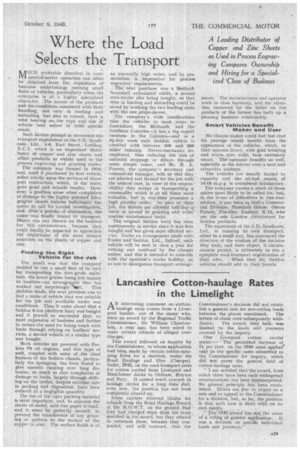Where the Load Selects the Transport
Page 31

If you've noticed an error in this article please click here to report it so we can fix it.
A Leading Distributor of Copper and Zinc Sheets as Used in Process Engraving Compares Ownership and Hiring for a Special ized 'Class of Business
NAUCII profitable direction in corn
. M thereial-motor operation can often be obtained from the experience of business undertakings running small. fleets of vehicles, particularly when the enterprise is of a highly specialized character. The nature of the products and the conditions associated with their handling, not only • in loading and unloading, but also in transit, have .a vital bearing on, the type and size of vehicle best suited to fulfil s.peci& needs.
Such factors prompt us-to recount tha transport experiences of the S.D. Syndicate, Ltd., 4-6, Earl Street, London, E.C,2, which is an important " distributor of copper and zinc sheets and allied products as widely used in the process engraving and printing trades.
The company was formed in 1926, and, until it purchased its first vehicle, relied wholly upon the services of transport contractors, which, in the main, gave good and reliable results. However, a position arose when cothplaints of damage to the highly polished lithographic sheets became sufficiently frequent. to Call for careful investigation, and; after a-process of eliinination, the cause was finally traced to transport. Blame was not thrown on the hauliers for this circumstance, because 'they could hardly be expected to appreciate the importance of the most minute scratches on the sheets of copper and
zinc. .
Finding the Right Vehicle for the Job The result was that the company decided to run a small fleet of its own lot transporting the first-grade. materials, the lower grades being left mainly to hauliers—au arrangement that has worked out surprisingly This decision made, the next problem was to • find a make of vehicle that was suitable for the job and .available under war conditions. Thus it came about that a Seddon 6-ton platform lorry was bought and it proved so successful that, to meet expansion of business and further to reduce the need for losing touch with loads through relying on hattliers' services, a second vehicle of a similar type was bought.
Both vehicles are powered with Perkins P6 oil engines, and this type of unit, coupled with some of the chief features of the Seddon chassis, particularly the springing, has been found to
• give smooth running over long . distances, so much so. that complaints of damage to loads, largely through shifting on the bodies, despite extreme care in packing and disposition, hare been reduced to a negligible quantity.
The use of the right packing material is most important, and, to separate the sheets of-metal, acid-free paper is-used, . and it must be perfectly smooth, to • prevent the transference of nn, Y 'graining or pattern to the surface of the copPer.or zinc. The surface finish is of an unusually high order, and its preservation is . imperative for process engravers.. requirements.
The next purchase was a BedfordScammpll articulated outfit, a second semi-trailer also being bought, so that time in loading and unloading could be saved by working the two loading units with the one prime-mover..
The company's wide ramifications take the vehicles to most areas in Lancashire, the Midlands, and the Southern Counties—it has a big export business in the Colonies—and in •a 5k-day week each Seddon vehicle is credited with between 500 and 600 miles' running. -Driver-mechanics are employed, thus reducing the risk of enforced stoppage or delays through some simple canse, and Mr. B. A. Forrest, the company's secretary and commercial manager, tells us that they are selected and trained for the job With the utmost care, in view of the respon-' sibility they accept in transporting a commodity which is at td1 times most 'valuable, but in war-time possesses a high priority order. As part of their job, the drivers are allotted half-day week to attend to greasing and other routine maintenance tasks.
The original Seddon lorry has been continuously in service since it was first bought and has given most efficient service. Under an arrangement made with Foster and Seddon, Ltd., Salford, each vehicle will be sent in once a year for vetting and overhaul by the chassis maker, and this is intended to coincide with the' operator's works holiday, so as not to. disorganize transport arrange
ments. The manufacturer and operator, work in close harmony, and. the attention bestowed by the latter on the products of the former has built up a pleasing business relationship.
Smart Vehicles Benefit Maker and User
No chassis maker could but feel that his prestige would benefit from the appearance of. the vehicles, which, in their maroon livery, with gold lettering and white tyre walls, look extremely smart. The operator benefits aswell, especially as the drivers wear a neat and attractive uniform.
The vehicles are usually loaded to capacity and the oil-fuel return, of 16-18 m.p g is considered satisfactory.
The company carries a stock of those spares most likely to be called for, but, in the event of difficulties in this connection, it can turn to Hall's Commercial Division, Standard House, Odeon Parade„ Einchley, London, N.12, who are the sole London distributors' for Seddon products. , .
The experience of the S.D. Syndicate, Ltd., in running its own transport, albeit in a small way, has convinced the directors of the wisdom of the decision they took, and their object, if circumstances permit, is ultimately to run a complete road-transport organization of
their own. When they do, Seddon vehicles should add to their laurels.




















































